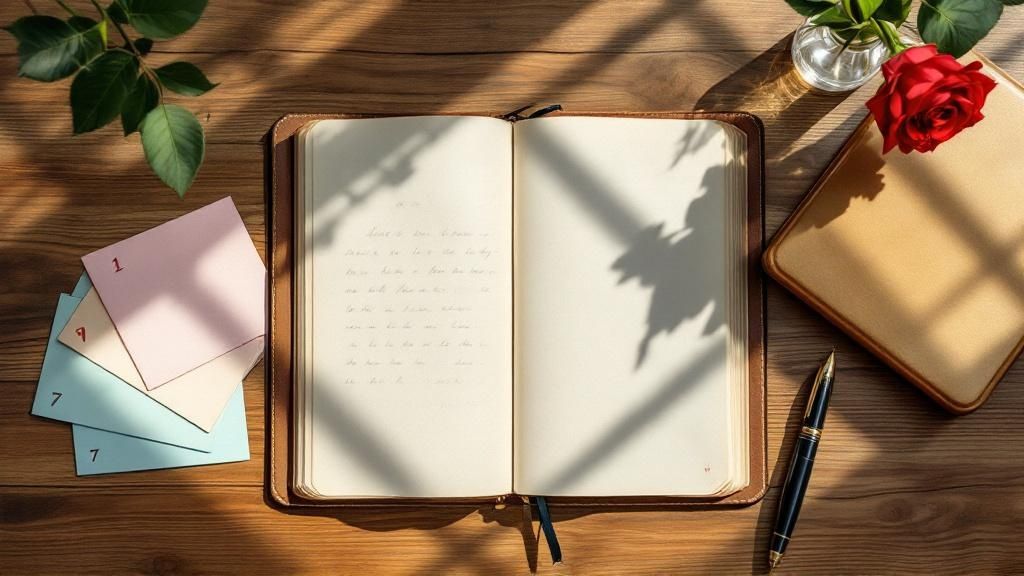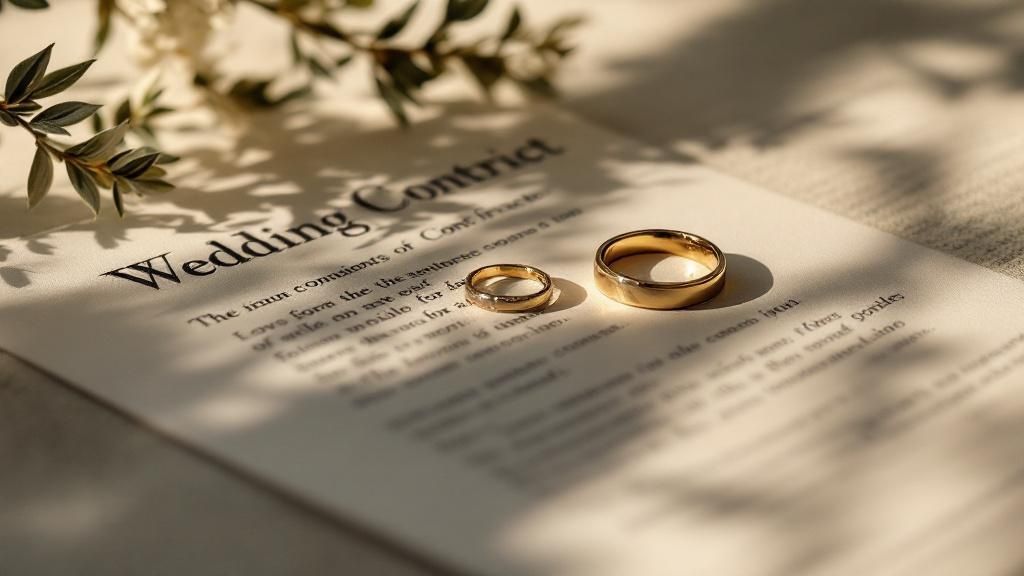Create Your Own AI Girlfriend 😈
Chat with AI Luvr's today or make your own! Receive images, audio messages, and much more! 🔥
4.5 stars

Every great love story begins with a single idea, a 'what if' that captures the imagination. Whether you're a seasoned author battling writer's block or a newcomer eager to pen your first tale, the right prompt can be the catalyst for an unforgettable narrative. Tropes are not just clichés; they are the foundational blueprints for stories that resonate deeply with readers. They provide a familiar structure that you can build upon, twist, and make entirely your own.
This guide explores seven classic yet versatile romance story prompts, offering fresh angles and actionable tips to move from a blank page to a fully-realized plot. We will break down the mechanics of what makes each scenario work, from Friends to Lovers to Forbidden Love. You'll gain specific tools to craft compelling characters, build sizzling tension, and deliver a satisfying emotional payoff. Get ready to find the spark for your next fan-favorite story.
1. Friends to Lovers
The "Friends to Lovers" trope is a classic for a reason. It taps into the powerful fantasy of finding love with the person who already knows you best. This romance story prompt explores the delicate, often awkward, transition from a deep platonic bond to a passionate romantic relationship, leveraging years of shared history and emotional intimacy as its foundation.

This setup provides an incredible opportunity for a rich, emotionally resonant narrative. The inherent conflict isn't about getting to know each other; it's about the risk of losing a cherished friendship for the chance at something more. Works like When Harry Met Sally... and Emily Henry's Beach Read masterfully capture this tension.
How to Write This Prompt
To make this story compelling, focus on the subtle shifts in your characters' dynamic.
- Subtle Tension: Introduce moments of unspoken attraction early on. This could be a lingering glance, a touch that lasts a second too long, or a moment of unexpected jealousy when a new partner enters the picture. These moments build a foundation of romantic potential that the characters themselves may not even recognize yet.
- Forced Proximity: Use external plot points to push your characters together in new, emotionally charged ways. A shared project, a vacation, or having to live together can force them to see each other in a different light, outside the comfortable safety of their established friendship.
- The Catalyst: Create a single, defining moment that shatters the platonic illusion. This "point of no return" forces them to confront their feelings head-on, whether it's an accidental kiss or a heartfelt confession during a crisis. This is a key turning point in any friends-to-lovers narrative.
Key Insight: The core conflict in a friends-to-lovers story is internal. The characters must overcome their own fear of change and the potential loss of their most important relationship to embrace a new kind of love.
This trope excels at creating a deeply satisfying "slow burn" romance that feels earned and believable. For more inspiration on crafting these intricate relationship dynamics, you can explore various scenarios and character interactions with AI. You can even try out roleplaying these scenarios yourself. Explore some friends to lovers AI roleplay prompts and see how the story can unfold. You might find some inspiration for your own writing by trying out some friends-to-lovers challenges and seeing how different characters react.
2. Enemies to Lovers
The "Enemies to Lovers" trope is a fan favorite, celebrated for its high-stakes tension and passionate emotional payoff. This romance story prompt thrives on the fiery dynamic between two characters who start with genuine animosity, only to discover that their intense feelings are rooted in a powerful, unspoken attraction. The journey from rivals to lovers is a dramatic transformation fueled by conflict and eventual understanding.

This setup is perfect for creating sparks that fly off the page. The initial conflict provides a natural barrier to love, making the eventual connection feel earned and deeply satisfying. Classic examples like Pride and Prejudice and modern hits like Sally Thorne's The Hating Game showcase how witty banter and heated arguments can pave the way for an epic romance.
How to Write This Prompt
To craft a believable enemies-to-lovers arc, focus on the evolution of their conflict into connection.
- Legitimate Conflict: Give your characters a valid reason to dislike each other beyond a simple misunderstanding. This could stem from opposing business goals, clashing moral codes, or a past betrayal. This grounds their animosity in reality and raises the stakes.
- Forced Proximity: engineer situations that compel them to interact. A shared project, being snowed in at a remote cabin, or being rival coaches for competing teams forces them to see beyond their initial prejudices and witness each other's hidden depths.
- The Vulnerability Reveal: Create a pivotal moment where one character sees the other in a moment of unexpected vulnerability. This could be a glimpse into a difficult family situation or a moment of professional failure. This act of seeing behind the "enemy" mask is crucial for shifting their perceptions.
Key Insight: The power of the enemies-to-lovers trope lies in the idea that the line between hate and passion is incredibly thin. The same intensity that fuels their arguments is what ignites their eventual romance.
This trope is ideal for writers who enjoy crafting sharp dialogue and a slow-burn narrative where emotional intimacy is won, not given. The satisfying resolution comes from watching two strong-willed individuals not just fall in love, but also grow as people by overcoming their own biases and pride.
3. Fake Dating/Marriage
The "Fake Dating/Marriage" trope thrives on delicious dramatic irony. It forces two characters into a pretend romantic relationship for mutual benefit, creating a high-stakes environment where the lines between performance and genuine emotion inevitably blur. This romance story prompt uses a clear external goal as the initial driver, allowing for a natural progression into authentic feelings.

This premise is a fantastic source of both comedy and tension. The central conflict arises from the characters trying to maintain a facade while grappling with unexpected, real feelings. Works like The Proposal, The Spanish Love Deception by Elena Armas, and Jenny Han's To All the Boys I've Loved Before masterfully showcase this dynamic, turning a simple arrangement into a compelling love story.
How to Write This Prompt
To craft a successful fake-dating narrative, focus on the rules of the arrangement and the moments they are broken.
- Establish Clear Stakes: Give both characters a compelling, non-negotiable reason for entering the fake relationship. One might need a date to a wedding to fend off family, while the other needs to appear "settled down" for a promotion. The stakes must be high enough to justify the deception.
- Set Rules to Be Broken: Create a contract or a list of rules for their fake relationship. These rules, such as "no kissing on the lips" or "no telling anyone the truth," provide a perfect framework for creating conflict and showing their growing intimacy as they inevitably break them.
- Blur the Lines: Introduce moments where the characters forget they are pretending. A shared laugh that feels too real, a moment of genuine protectiveness, or an intimate confession can show the audience, and the characters, that their fake feelings are becoming authentic.
Key Insight: The heart of a fake dating story is the tension between the public performance and the private, burgeoning reality. The story's climax often forces a choice: abandon the fake arrangement or risk everything to make it real.
This trope is perfect for exploring themes of vulnerability and the difference between perception and reality. Watching characters navigate public events while hiding their secret arrangement provides endless opportunities for humorous and heart-wrenching scenarios, making for an engaging romance story prompt.
4. Second Chance Romance
The "Second Chance Romance" trope is a powerful and emotionally charged prompt that resonates deeply with readers. It centers on former lovers who reunite years after a painful breakup, forcing them to confront their shared history, personal growth, and the lingering question of "what if." This romance story prompt is built on themes of forgiveness, maturity, and the bittersweet nature of timing.

This setup creates a rich narrative landscape filled with built-in conflict and emotional weight. The characters already have a deep, complex history, allowing the story to explore whether love can truly conquer past hurts and stand the test of time. Works like Nicholas Sparks' The Notebook and the film La La Land expertly capture the nostalgic and often heart-wrenching pull of a past love.
How to Write This Prompt
To write a compelling second chance romance, you must convincingly show why the relationship is different this time around.
- Demonstrate Growth: Show, don't just tell, how the characters have matured during their time apart. What life experiences have changed their perspectives or fixed the flaws that once drove them apart? This growth is essential for the second chance to feel earned and believable.
- Address the Breakup: The original reason for their separation must be addressed directly. Whether it was a misunderstanding, immaturity, or external pressures, confronting this core conflict head-on is crucial for healing and moving forward, both for the characters and the reader.
- Create New Obstacles: While the past is important, introduce new, present-day challenges that test their renewed connection. This could be current partners, career conflicts, or family obligations that prove their relationship is strong enough to survive today's problems, not just yesterday's.
Key Insight: The core conflict in a second chance romance is about proving that the timing is finally right. The characters must demonstrate that they have become the people they needed to be to make their love last.
5. Workplace Romance
The Workplace Romance trope brings love into the professional world, creating a high-stakes environment where personal feelings and career ambitions collide. This romance story prompt explores the thrill of a forbidden or complicated relationship that must navigate corporate policies, power dynamics, and the constant risk of professional fallout. The tension is built-in, as characters must balance their hearts with their livelihoods.
This setup is ripe for both slow-burn tension and dramatic conflict. The challenge isn't just about falling in love; it's about whether that love can survive the unique pressures of a shared professional life. Iconic examples like Jim and Pam in The Office or the central relationship in The Proposal showcase how professional settings can both hinder and ultimately foster deep romantic connections.
How to Write This Prompt
To craft a compelling workplace romance, focus on how the professional environment shapes the relationship.
- Professional Attraction: Show the characters being attracted to each other’s professional skills first. One might admire the other's brilliant presentation, sharp negotiation tactics, or dedication to a project. This creates a foundation of mutual respect that evolves into romance.
- Forced Collaboration: Use work-related scenarios to push them together. A high-pressure project, a business trip, or being assigned as partners forces them into close proximity, blurring the lines between their professional and personal selves.
- External vs. Internal Stakes: Create tension using both external professional risks (getting fired, office gossip, a promotion on the line) and internal emotional risks (fear of ruining a good working relationship, navigating a power imbalance). This dual-layered conflict makes their choices more meaningful.
Key Insight: In a workplace romance, the central conflict is often about boundaries. The characters must constantly negotiate the line between their public professional personas and their private romantic feelings, making every interaction charged with meaning.
This trope allows for a romance that feels earned, as the couple must overcome tangible, real-world obstacles together. For more insights on navigating the complexities of modern relationships, you can learn more about dating and relationship dynamics to add more realism to your story.
6. Opposites Attract
The "Opposites Attract" trope is a cornerstone of romantic fiction, driven by the captivating idea that two people with wildly different personalities, backgrounds, or values can find a perfect, complementary balance. This romance story prompt thrives on friction and discovery, as characters are forced to look beyond surface-level differences to find a deeper connection.
This setup is a fantastic source of both external conflict and internal growth. The initial clashes between characters provide witty banter and high-stakes tension, while their journey toward understanding each other leads to profound character development. Iconic examples like Pride and Prejudice (the reserved aristocrat and the spirited gentlewoman) and The Proposal (the rigid boss and her easygoing assistant) showcase this dynamic perfectly.
How to Write This Prompt
To make this classic trope feel fresh and compelling, focus on creating authentic friction and meaningful growth.
- Meaningful Differences: Go beyond simple "slob vs. neat freak" clichés. Create fundamental differences in values, life goals, or core beliefs. This provides a much richer source of conflict and makes their eventual union more satisfying. Is one a risk-averse planner and the other a spontaneous thrill-seeker?
- Show, Don't Tell Complementarity: Instead of stating they balance each other out, demonstrate it. Show a scene where one character’s impulsiveness saves the other from overthinking, or where one’s careful planning prevents a disaster. Their strengths should actively fill the other's gaps.
- Demonstrate Mutual Growth: The key is that both characters must evolve. It’s not about one person "fixing" or changing the other. Show how each character learns from their partner, adopting some of their positive traits and becoming a more well-rounded person because of the relationship.
Key Insight: The heart of an opposites attract story isn't just the conflict their differences create, but the discovery that those very differences make them stronger together than they ever were apart.
This trope offers a powerful narrative arc that moves from conflict to harmony. You can explore a wide range of these character dynamics with AI to generate unique romance story prompts. Playing with different combinations, like a cynical scientist paired with a hopeful artist, can unlock fresh and exciting plot possibilities for your next story.
7. Forbidden Love
The "Forbidden Love" trope is a cornerstone of romantic fiction, creating high-stakes drama by placing powerful external barriers between two people destined for each other. This romance story prompt thrives on the intense conflict between overwhelming desire and societal duty, forcing characters to risk everything for a love that is deemed unacceptable. The tension comes from the very real consequences of their union.
This setup is perfect for generating powerful, page-turning suspense alongside deep emotional connection. The core conflict is external, stemming from family feuds, social class divides, professional ethics, or cultural taboos. Timeless stories like Shakespeare’s Romeo and Juliet and modern classics like the film Titanic showcase how this forbidden element amplifies the passion and stakes of the relationship.
How to Write This Prompt
To make this story resonate, the forbidden aspect must feel inescapable and genuinely threatening.
- Establish Clear Stakes: The reasons for the prohibition must be concrete and believable. Is it a rival family, a strict religious law, or a professional code of conduct? Show the audience exactly what the characters stand to lose: their family, their career, their social standing, or even their lives.
- Create Near-Misses: Build suspense with moments where the couple is almost discovered. These close calls escalate the tension and reinforce the constant danger they are in. A hidden letter nearly found, a whispered conversation almost overheard, or a secret meeting nearly interrupted keeps the reader on edge.
- Explore the Emotional Cost: Secrecy takes a heavy toll. Focus on the characters' internal struggles, their guilt, fear, and the isolation they feel from hiding such a significant part of their lives. This internal conflict adds a rich layer of psychological depth to the external drama.
Key Insight: The power of a forbidden love story lies in its central question: Is love worth the price of rebellion? The characters' choices, whether they defy the rules or ultimately bow to them, reveal their deepest values and create a poignant, unforgettable narrative.
This trope is excellent for writers looking to craft a story with inherent high stakes and immediate conflict. For more ideas on how to weave this intense dynamic into your narratives, you can explore various scenarios within the genre. Learning more about forbidden romance tropes can provide further inspiration for creating compelling characters and plot points.
7 Romance Story Prompts Comparison
| Trope | Implementation Complexity 🔄 | Resource Requirements ⚡ | Expected Outcomes 📊 | Ideal Use Cases 💡 | Key Advantages ⭐ |
|---|---|---|---|---|---|
| Friends to Lovers | Moderate – needs careful balance of friendship and romance | Moderate – focus on emotional build-up | Slow but natural romantic progression | Stories emphasizing deep emotional intimacy | Realistic development and strong emotional stakes |
| Enemies to Lovers | High – balancing conflict with chemistry | Moderate to High – complex character arcs | Intense, passionate romance with growth | Narratives driven by tension and transformation | High emotional stakes and satisfying arcs |
| Fake Dating/Marriage | Moderate – clear rules and gradual blur | Moderate – requires believable motivations | Tension from fake vs real emotions | Stories with built-in conflict and comedic elements | Built-in tension with structured progression |
| Second Chance Romance | Moderate to High – justifying character growth | Moderate – requires backstory and growth | Emotional depth with redemption themes | Mature romances exploring forgiveness and growth | Rich backstory and emotional complexity |
| Workplace Romance | Moderate – must handle professional ethics | Moderate – use of professional settings | Conflict between career and romance | Contemporary settings with power dynamics | Forced proximity and relatable modern context |
| Opposites Attract | Moderate – believable contrasts essential | Low to Moderate – character-driven | Balanced harmony from conflict | Stories focusing on complementary differences | Natural conflict with satisfying resolution |
| Forbidden Love | High – managing external barriers and stakes | Moderate – scenario and consequence heavy | Dramatic, intense romance with high stakes | Tales of social or cultural barriers | Inherent drama and passionate connection |
Bring Your Romance Story to Life
The romance story prompts we've explored are more than just simple ideas; they are powerful narrative frameworks. From the slow-burn satisfaction of Friends to Lovers to the explosive tension of Enemies to Lovers, each trope provides a proven structure for crafting a compelling emotional journey. We've seen how the high stakes of a Fake Dating scenario can force vulnerability, while a Second Chance Romance allows you to delve into mature themes of regret and forgiveness.
The true magic happens when you take these foundational concepts and make them your own. The key is not just to follow the formula but to innovate within it. Ask yourself how you can subvert expectations in a classic Workplace Romance or what unique external pressures can amplify a Forbidden Love story. The most memorable stories are born from a writer's unique voice and perspective applied to a structure readers already know and love.
From Prompt to Page
Transforming a great idea into a fully realized story requires more than just a starting point. It involves experimentation, character exploration, and refining the subtle nuances of dialogue and interaction. Your next steps should focus on action:
- Select a Prompt: Choose one of the romance story prompts that genuinely excites you and sparks your imagination.
- Ask "What If?": Challenge the core concept. What if your "opposites attract" characters share a secret, obscure passion? What if the "fake marriage" is for a reason no one would ever suspect?
- Outline the Core Conflict: Identify the primary internal and external obstacles that will keep your characters apart. This is the engine of your plot.
- Write the First Scene: Don't wait for perfection. Dive in and write the scene where your characters first meet or where the central conflict is established. This momentum is invaluable.
Ultimately, these romance story prompts are your invitations to create a world filled with passion, tension, and heartfelt connection. By understanding their mechanics and infusing them with your creativity, you can build a narrative that will resonate deeply with readers and leave them breathless. Pick your favorite, embrace the challenge, and begin writing the unforgettable love story you were meant to tell.
Ready to test your dialogue or workshop a difficult scene? Bring your characters to life with Luvr AI, an immersive platform where you can role-play scenarios and perfect your character dynamics in real-time. Transform your promising romance story prompts into compelling narratives by visiting Luvr AI today.



